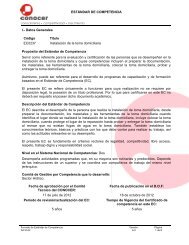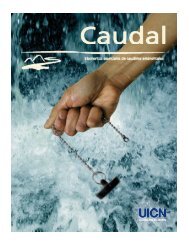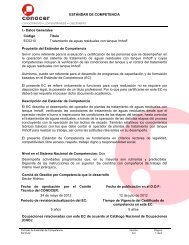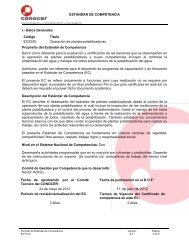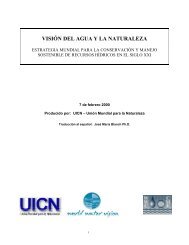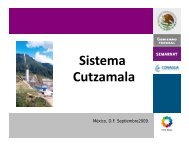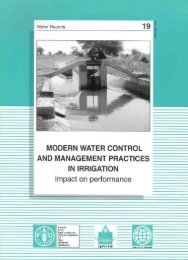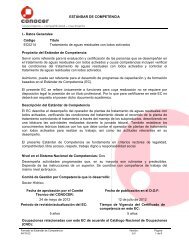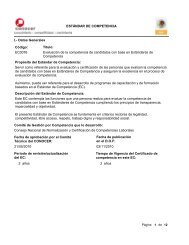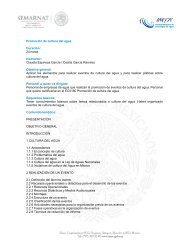Agricultural drainage water management in arid and semi ... - FAO.org
Agricultural drainage water management in arid and semi ... - FAO.org
Agricultural drainage water management in arid and semi ... - FAO.org
Create successful ePaper yourself
Turn your PDF publications into a flip-book with our unique Google optimized e-Paper software.
34Water quality concerns <strong>in</strong> <strong>dra<strong>in</strong>age</strong> <strong>water</strong> <strong>management</strong>dem<strong>and</strong> (BOD). Subsurface <strong>dra<strong>in</strong>age</strong> is enriched <strong>in</strong> soluble components such as dissolved m<strong>in</strong>eralsalts <strong>and</strong> nitrates, very low <strong>in</strong> sediments, whereas other quality parameters are similar to theirrigation <strong>water</strong>. These changes <strong>in</strong> <strong>water</strong> quality of irrigation return flow depend on a number offactors <strong>in</strong>clud<strong>in</strong>g irrigation application methods, soil properties <strong>and</strong> conditions, application ofagricultural chemicals, hydrogeology, <strong>dra<strong>in</strong>age</strong> system, climate, <strong>and</strong> farmers’ <strong>water</strong> <strong>management</strong>.In many regions of the world, municipalities <strong>and</strong> <strong>in</strong>dustries discharge waste<strong>water</strong> <strong>in</strong>to opendra<strong>in</strong>s <strong>in</strong>itially <strong>in</strong>tended for the conveyance of only agricultural <strong>dra<strong>in</strong>age</strong> <strong>and</strong> storm <strong>water</strong>. Indevelop<strong>in</strong>g countries especially, municipal <strong>and</strong> <strong>in</strong>dustrial waste<strong>water</strong> is often <strong>in</strong>sufficiently treatedbefore disposal <strong>in</strong>to such open dra<strong>in</strong>s. The result is a risk that agricultural <strong>dra<strong>in</strong>age</strong> <strong>water</strong> qualitymight be seriously contam<strong>in</strong>ated with microbes, pathogens, toxic <strong>org</strong>anics <strong>and</strong> trace elements<strong>in</strong>clud<strong>in</strong>g heavy metals.A knowledge of the composition of the <strong>dra<strong>in</strong>age</strong> effluent <strong>and</strong> the ability to predict changes <strong>in</strong>the composition as a result of changes <strong>in</strong> crop, irrigation or <strong>dra<strong>in</strong>age</strong> <strong>water</strong> <strong>management</strong> practicesare important <strong>in</strong> the plann<strong>in</strong>g <strong>and</strong> <strong>management</strong> of <strong>dra<strong>in</strong>age</strong> <strong>water</strong>.FACTORS AFFECTING DRAINAGE WATER QUALITYGeology <strong>and</strong> hydrologyThe geology of the region plays an important role <strong>in</strong> <strong>dra<strong>in</strong>age</strong> <strong>water</strong> quality. Through weather<strong>in</strong>gprocesses, the types of rocks (both primary <strong>and</strong> sedimentary) <strong>in</strong> the upper <strong>and</strong> lower stratadef<strong>in</strong>e the types <strong>and</strong> quantities of soluble constituents found <strong>in</strong> the irrigated area. The oceanshave submerged many parts of the cont<strong>in</strong>ents dur<strong>in</strong>g a period <strong>in</strong> their geological history. Theuplift of these submerged geological formations <strong>and</strong> reced<strong>in</strong>g seas have left mar<strong>in</strong>e evaporites<strong>and</strong> sedimentary rocks beh<strong>in</strong>d, high <strong>in</strong> sea salts <strong>in</strong>clud<strong>in</strong>g sodium, chloride, magnesium, sulphate<strong>and</strong> boron. These geological formations exist <strong>in</strong> vary<strong>in</strong>g thicknesses, depths <strong>and</strong> extents on thecont<strong>in</strong>ents. Through hydrological processes, solutes can enter the upper stratum by irrigation orflood<strong>water</strong>, upward ground<strong>water</strong> flow <strong>in</strong> seepage zones, with ris<strong>in</strong>g ground<strong>water</strong> levels, or capillaryrise. Once the solutes are <strong>in</strong> the upper strata, they <strong>in</strong>fluence the quality of agricultural <strong>dra<strong>in</strong>age</strong><strong>water</strong> through farmers’ irrigation <strong>and</strong> <strong>dra<strong>in</strong>age</strong> <strong>water</strong> <strong>management</strong>. The follow<strong>in</strong>g example showshow the geology <strong>and</strong> hydrology of an area <strong>in</strong>fluence the quality of agricultural <strong>dra<strong>in</strong>age</strong> <strong>water</strong>. Italso illustrates the relationship between geomorphology, <strong>water</strong>logg<strong>in</strong>g <strong>and</strong> sal<strong>in</strong>ization.Figure 12 shows a schematic crosssectionof the San Joaqu<strong>in</strong> Valley withthe San Joaqu<strong>in</strong> River as the pr<strong>in</strong>cipal<strong>dra<strong>in</strong>age</strong> course for this river bas<strong>in</strong>. Theeastern side of the valley was formedfrom the alluvium of the Sierra Nevada,which consists ma<strong>in</strong>ly of granitic rocks.The soils derived from Sierran alluviumtend to be coarse textured <strong>and</strong> nonsal<strong>in</strong>e.The eastern ground<strong>water</strong>s arecharacterized as low-salt calciumbicarbonate-type<strong>water</strong> with totaldissolved solids (TDS) typically <strong>in</strong> the200-500 mg/litre range. In contrast, thesoils on the western side were formedFIGURE 12Cross-section of the San Joaqu<strong>in</strong> ValleyCoast RangeMar<strong>in</strong>esedimentary rocksCaliforniaAqueductvSalt-affectedSan Joaqu<strong>in</strong>RiverNon-sal<strong>in</strong>eUnconf<strong>in</strong>ed ground<strong>water</strong>Conf<strong>in</strong>ed ground<strong>water</strong>Sierra NevadaIgneousrocksCorcoran clayConsolidated rocks



